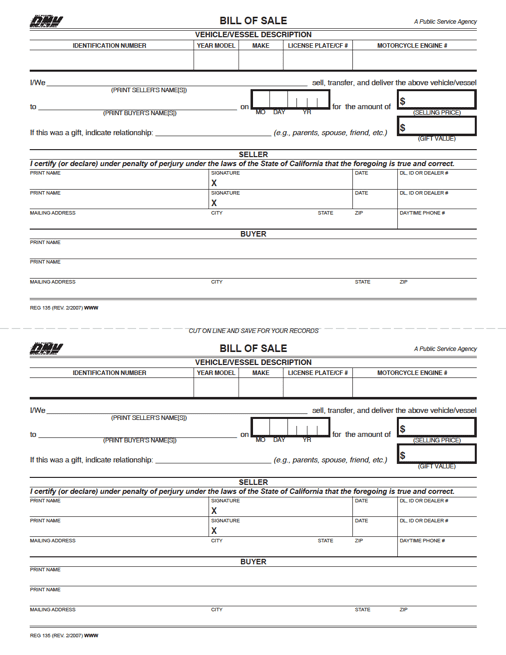California Motor Vehicle Bill of Sale Form
A California motor vehicle bill of sale form addresses the deal that a buyer and seller made for an automobile. The transaction can happen through the exchange of funds, trade, or gift. If the owner gives another person ownership of the car as a present (i.e., $0), they need to complete additional documentation to verify the transfer. Otherwise, a bill of sale provides enough evidence to prove ownership and the legal exchange of property.
|
What is a California Car Bill of Sale?
A California car bill of sale has information that allows the owner to register, title, sell, or buy a vehicle. The Department of Motor Vehicles (DMV) requires individuals to use Form REG 135 when purchasing or selling a car. It does not include an odometer disclosure statement. Instead, both parties must complete Form REG 262 and Form REG 256 if the title does not contain the mileage reading.
If more than one (1) person owns the vehicle, both co-owners need to print their full name and sign. They must also provide their California driver’s license or state ID number and the date of signing. Otherwise, the DMV can reject the document since both owners did not authenticate the deal.
How to Register a Car in California (4 Steps)
California drivers must register their vehicle within ten (10) days of becoming residents. Dealers have thirty (30) days to report the sale and register a new car and twenty (20) days for a used car. If a driver operates an unregistered vehicle, law enforcement can ticket them (§ 4000 (a)(1)).
Private sellers must inform the Department of Motor Vehicles (DMV) that they have sold their vehicle within five (5) days of the sale. They must send in the following:
- The buyer’s information (i.e., name, address, phone number, and email.);
- The car information (i.e., license plate number, last five (5) numbers of vehicle identification number);
- A signed odometer disclosure statement; and
- A transfer and release of liability (Form REG 138).
Step 1 – Obtain California Motor Vehicle Insurance
The DMV requires registrars to have an active insurance policy. The plan must cover one person’s bodily injury or death ($15,000) and two or more people’s bodily injury or death ($30,000). It must also take care of property damage for each incident ($5,000).
Step 2 – Submit Registration Forms
Individuals can make an appointment with the DMV to register their car for the first time in California. Before attending, they must ensure they have the required forms and payment.
Residents can also use the online portal to complete their vehicle registration. This process does not require a trip to the DMV and decreases the time demand.
| Bring the Following: |
Step 3 – Apply Tabs + License Plates
Once the DMV approves the application, the owner receives license plates, which they must fasten to the appropriate area of the vehicle. In addition, they must attach the provided stickers to the license plate so that law enforcement and other officials can see them at all times.
Step 4 – Renew Annually
Vehicle registration in California lasts for one (1) year. Renewals can occur in person, by mail, or online.
Residents can reapply up to sixty (60) days before their current registration expires. However, they can only apply for an early renewal if they have the written reminder from the DMV in hand. Otherwise, they must wait until they receive the notice. They must also provide their license plate number, the last five (5) digits of their VIN, and a form of accepted payment.
| Mailing Address: |
| DMV Renewal PO Box 942897 Sacramento, CA 94297-0897 |
